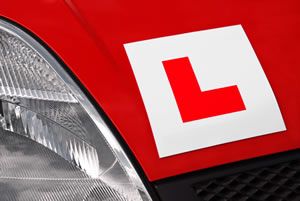Learner Driver Rules
When you're just starting to drive there are lots of rules to get your head around, but don’t worry, we’ve made it easy for you to learn them! We've answered some of the most common questions we're asked about the rules for learning to drive.
Click on a question to jump to the answer:
- What sort of licence must a learner driver have?
- What sort of insurance should a learner driver have?
- Must learner drivers be supervised?
- Does a learner driver have to use L plates on their vehicle?
- Can learner drivers drive on a motorway?
- What's the speed limit for a learner driver?
- Can learner drivers have passengers?
- Can learner drivers drive at night?
- What's the minimum age for taking a driving test?
- Learner driver rules for mopeds and tractors
What must learner drivers do before they start driving on the road?
- Have a valid provisional driving licence for Great Britain and N. Ireland. If you don't already have one, you can apply for a provisional licence online.
- Ensure that your car is road-worthy – most vehicles must have a valid MOT certificate once they are three years old (there are exceptions, but unless you’re planning to drive a taxi, ambulance or large passenger vehicle such as a mini-bus, three years is the norm)
- Have current road tax
- Arrange proper insurance (preferably in your own name, so you can start earning a no claims bonus right away, even while you’re still learning to drive).
- Be able to read a new-style number plate from a distance of 20 metres (roughly 66 feet) or an old-style plate from 20.5 metres (roughly 67 feet). If you need glasses or contact lenses to meet the requirement, you must wear them every time you drive.
Changes to driving licence rules – January 2013
More rules for learner drivers to be aware of! On 19th January 2013 driving licence rules changed in Great Britain and Northern Ireland.
Learner drivers applying for a provisional licence to drive or passing a driving test from this date will need to know the new rules, which mostly apply to motorcycle and moped licences, the motorcycle practical test and drivers of buses and lorries.
Rules for learning to drive
- If you want to practice driving before you’ve passed your test, you must be accompanied by a qualified driver (full driving licence for at least three years) over the age of 21. They must also be fit to drive, including being under the drink driving limit and not using a mobile phone.
- Learner drivers must display “L” plates (or “D” plates in Wales) somewhere on both the front and rear of your car that's highly visible to other drivers.
- Learner drivers can't currently drive on motorways (though the government is considering changing the rules on this). You can drive on all other types of road, including dual carriageways, if properly supervised.
- Learner drivers in the UK must abide by the speed limit in force on any given road they are driving on, with the exception of Northern Ireland where a maximum speed limit of 45mph applies to any vehicle displaying "L" plates, even on dual carriageways.
Can learner drivers have passengers?
Learner drivers can have passengers as long as the front seat passenger seat is occupied by a qualified driver.
Can learner drivers drive at night?
Learner drivers can drive at night, as long as they are correctly supervised.
Minimum age for taking a driving test
You can apply for a provisional licence up to three months before your 17th birthday, but the earliest it will become valid is your 17th birthday. On this date you can legally take your theory test.
Mopeds and tractors
If you want to ride a moped, you can take your theory test at the age of 16 if you have a valid provisional licence. Your provisional licence will also include entitlement to drive a car, but this will not come into effect until your 17th birthday.
Next steps
We hope you've found this helpful. If you've already got your own vehicle, get in touch with us for a quote for insurance while you're learning to drive.

